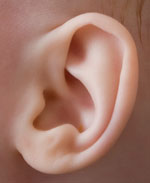 The debate rages: What’s the best approach for treating one of the most common maladies of childhood: ear infections? The conflict centers on the use of antibiotics, surgery and “watchful waiting.” In the past, pediatricians were quick to call a red eardrum an infection and whip out the prescription pad. But in recent years, new evidence has brought awareness to the problems caused by overuse of antibiotics and the fear of drug-resistant bacteria. This has prompted many doctors and parents to take a “watchful waiting” approach to see if the child gets better without medicine.
The debate rages: What’s the best approach for treating one of the most common maladies of childhood: ear infections? The conflict centers on the use of antibiotics, surgery and “watchful waiting.” In the past, pediatricians were quick to call a red eardrum an infection and whip out the prescription pad. But in recent years, new evidence has brought awareness to the problems caused by overuse of antibiotics and the fear of drug-resistant bacteria. This has prompted many doctors and parents to take a “watchful waiting” approach to see if the child gets better without medicine.
The first official guidelines for all things related to ear infection came out in 2004. The American Academy of Pediatrics recommends using an over-the-counter pain medication for the first few days, and, for children older than 6 months, waiting 48 to 72 hours to see if the infection will resolve on its own without antibiotic treatment. The guidelines do not say that antibiotics should not be used, but instead help determine when antibiotics are truly needed.
“It’s very hard to tell what the cause of the ear infection is,” says Dr. Seth Schwartz, who practices otolaryngology (ear, nose and throat) at Virginia Mason Medical Center in Seattle. “Sometimes it’s virally related and sometimes it’s bacterial. The only way to know for sure is to tap the fluid in the ear and test it, and we don’t want to do that.
“A lot of the time, acute infections will get better with the child’s own immune-system response,” Schwartz says, “but the problem with chronic ear infections is that after the initial infection is cleared and the inflammation has gone down, the fluid remains for quite some time.” In some children, this can be a recurring problem.
Totally tubular?
Opinions differ on when to opt for vent tubes to help fluid drain from the ear, but Schwartz says his office suggests it when a child has three ear infections in six months or more than five infections in a year.
If left untreated, Schwartz says, persistent fluid can temporarily reduce a child’s hearing by 20 percent to 30 percent. “It feels like their ears are plugged, like putting your fingers in your ears,” he says. A busy preschooler may get used to the feeling of having her ears “plugged” and not complain, making it harder for parents to recognize the problem.
Ear infections tend to peak twice in early childhood, Schwartz says, once around age 2, and then again at age 4. But as children grow (usually by age 6), there is more space in the middle ear after the Eustachian tube has lengthened, giving the ear better ventilation and resulting in fewer infections. So parents may conclude that after a child has reached school age, side effects of ear infections are a thing of the past. But maybe not. Some new studies have found a link between chronic ear infections and a higher risk of obesity.
An obesity connection?
Linda Bartoshuk, Ph.D., a taste researcher at the University of Florida, found that frequent ear infections can alter taste perception and lead to a powerful preference for high-fat and highly sweetened foods, which, over time, can lead to obesity. Bartoshuk discovered that people with a history of frequent ear infections were 62 percent more likely to be obese. In another study, preschoolers who developed frequent ear infections were found to eat fewer vegetables and crave more sweets than children who did not get ear infections.
So how can fluid in the ear be connected to taste? “There’s a nerve that passes right through the middle ear space then goes out through the anterior two-thirds of the tongue,” Schwartz says. Called the chorda tympani, this nerve carries taste messages from the tongue to the brain. When the chorda tympani is damaged, it can make the other nerves less responsive, and based on Bartoshuk’s research, the damage from frequent ear infections might change taste preference.
The discovery of a possible connection between obesity risk and chronic ear infections is new and needs more study. But it suggests that parents of preschoolers who routinely get ear infections should not dismiss them as a common affliction of childhood and skip the trip to the pediatrician’s office. Each infection needs to be monitored to make sure fluid does not linger. “Many times the ear infection will get better without the use of antibiotics,” says Schwartz. “But it’s still important those children are followed closely, so if things don’t get better, they can be properly treated.”
Katie Amodei is a Puget Sound-based freelance writer, wife, mother and stepmother.









